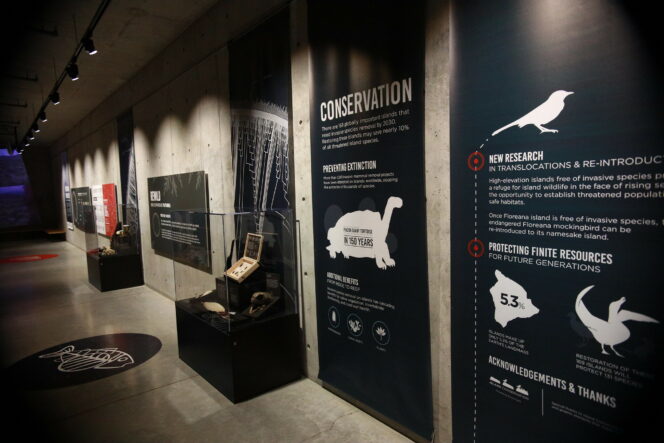
Photo: Christopher Mortenson – Beaty Biodiversity Museum
Beaty Biodiversity Museum, located on the University of British Columbia main campus, is an under-the-radar gem. From now until October 23, 2022, it houses a transformative exhibition that invites visitors to perceive and interact with their local environment and their planet differently.
Part natural history museum, part educational facility, and part research centre, the Beaty Biodiversity Museum is truly special and very much speaks to the values of this city in terms of nature, conservation, and sustainability.
It has the privilege of currently being the home of the exhibition Preventing Extinctions: Architecting the Accretocene, conceived by writer and conservation photographer Andrew S. Wright and curated by Michael Fairchild-Simms and Yukiko Stranger-Galey. Wright is also on the Advisory Council for Island Conservation. The exhibition represents collaboration between the Beaty Biodiversity Museum and Science World, as well as Canada’s National Observer and the Tyee. The exhibition was mounted in Science World and now has been reimagined for the Beaty Biodiversity Museum.
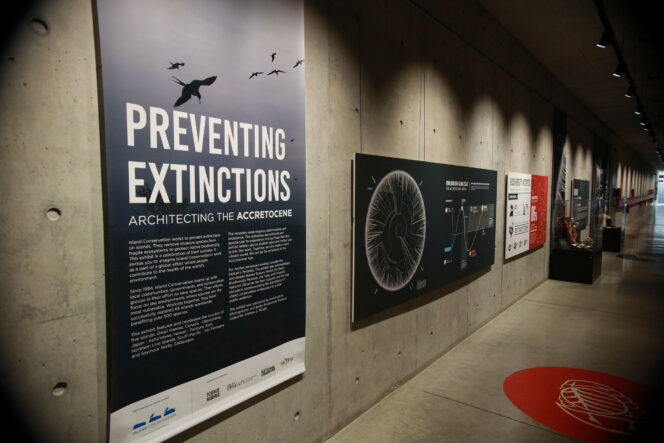
Photo: Christopher Mortenson – Beaty Biodiversity Museum
Located in a corner section of the museum, Preventing Extinctions contains stunning photography, infographics, natural specimens, as well as video imagery that will hopefully inspire and motivate visitors to join the work of preserving biodiversity.
The exhibition focuses on the efforts of an organization called Island Conservation that tirelessly combats extinction on islands. Wright is hoping to contribute to a shift from an Anthropocene to an Accretocene. In a chapter from his book The Pelican’s Paradise, Wright defines Anthropocene as “the period during which human activities have had an environmental impact on the Earth regarded as constituting a distinct geological age.” In other words, it’s the age in which humans are negatively affecting the planet through activities like resource extraction and urban expansion.
As bleak as this sounds, Wright offers optimism by championing the term Accretocene, “during which proposed human activities catalyze rewilding and biodiversity growth on the Earth.”
Derek Tan, one of the designers of the exhibition and digital producer at the Beaty Biodiversity Museum, describes the proposed age as follows: “It’s the idea that human activities can promote biodiversity through things like invasive species removal and then the introduction of native species back to human disturbed areas. People can have a positive impact on the environment and reverse some of the biodiversity loss that we’ve seen in the past eon.” In short, humans can globally choose to help the planet recover and flourish.
In order to make this abstract idea more concrete, Preventing Extinctions focuses on five island case studies in order to illustrate the kind of positive change that is possible: Okinoshima, Japan; Kaho’olawe, Hawaii; Palmyra Atoll, Northern Line Islands, South Pacific; Isla Floreana and Seymour Norte, Galapagos; and closer to home Gwaii Haanas, Canada.
These represent five out of the 65 islands that have benefited from the work of Island Conservation since the organization’s inception in 1994. In collaboration with local conservation groups, governments, and communities, Island Conservation protects native species by removing invasive ones.
The exhibit uses an infographic to visually showcase the Accretocene Vision. A powerful graph underlines the urgency of acting now in order to prevent devasting loss of biodiversity before it is too late. Otherwise, it may take millions of years for the planet to recover.
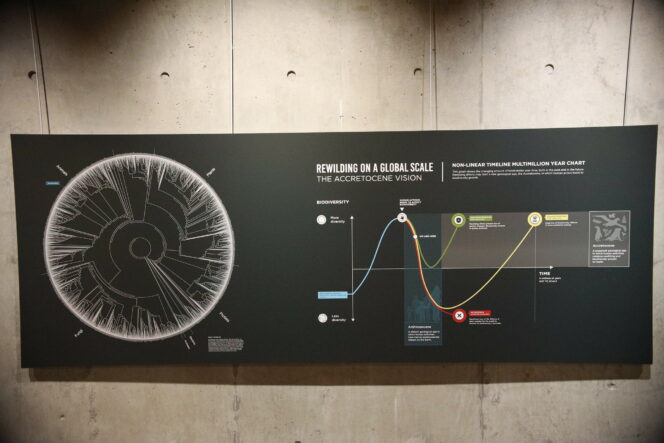
Photo: Christopher Mortenson – Beaty Biodiversity Museum
Other infographic panels provide compelling info regarding the significance of islands as “Biodiversity Hotspots.” “You have a lot of visual elements showing the different types of animals. It’s a really engaging design, lots of big shapes and silhouettes of different animals that people can recognize,” says Tan. For example, a silhouette of a dodo educates that 75% of bird, amphibian, mammal, and reptile extinctions occur on islands. Meanwhile, images of invasive mammals, such as rats and goats, highlight how they played a role in 86% of recorded extinctions on islands. Another with an image of the Pinzon giant tortoise shows how invasive species removal on 169 islands could save almost 10% of the species on islands that are threatened.
Specimens from the museum’s collections provide concrete evidence of the effects of the Anthropocene as well as positive interventions. A shell of a Lewis’s moonsnail shows how climate change can affect biodiversity. The snails crawled out of their shells, and many of them died during 2021 when tides were low in Puget Sound and the BC heat dome made temperatures insufferable. A white tern is also on display. Invasive rats preyed on their eggs; the bird population has increased since the rats’ elimination from Palmyra Atoll.
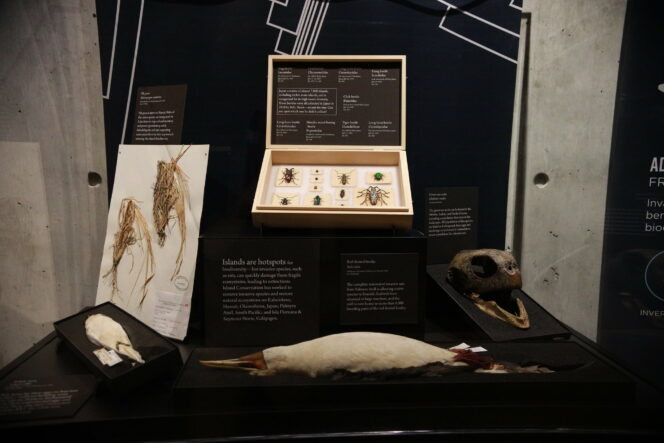
Photo: Christopher Mortenson – Beaty Biodiversity Museum
Most compelling of all are the stunning photos taken by Wright from the five islands. They show images that range from a sea lion rookery at Garcin Rocks in the Hecate Strait in British Columbia to a striking peregrine falcon in Koyashima Islet in Japan. The vibrant colours and specificity of the wildlife in the photos highlight the biodiversity that is well worth preserving. In his book, Wright talks about “the global ecosystem, a collection of fully integrated symbiotic flora and fauna,” one which human activities disrupt.
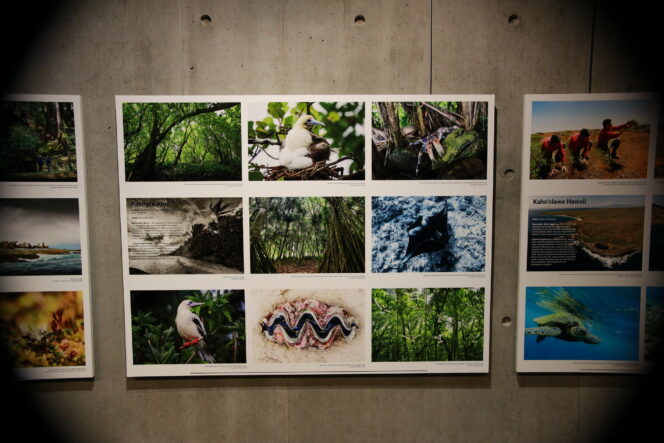
Photo: Christopher Mortenson – Beaty Biodiversity Museum
Tan says the exhibition is meant to invoke awareness and action in the visitor at both the global and local level. “People can sometimes forget about the level of biodiversity we have in our own backyard. One of the islands we’re focusing on is Haida Gwaii. It’s important to remember that we have an incredibly biodiverse ecosystem not only in our province, but also around Vancouver and around urban spaces. So, people can think about what they can do locally to impact local biodiversity,” he says.
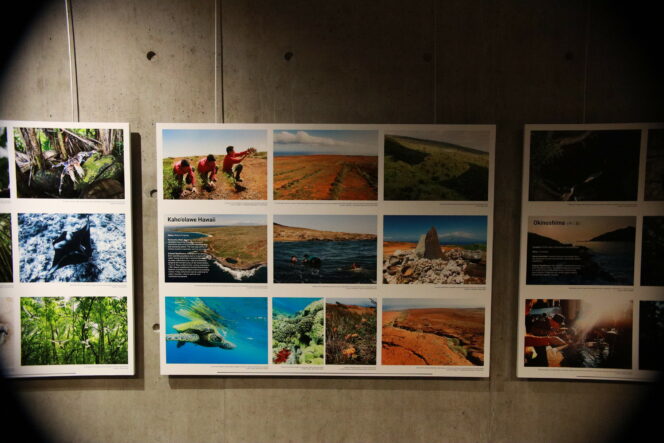
Photo: Christopher Mortenson – Beaty Biodiversity Museum
Tan says that invasive species removal, which is a focus of Island Conservation’s work, is actively ongoing in Vancouver. For example, it’s happening at Pacific Spirit Regional Park, there’s the Stanley Park Ecology Society, and the Invasive Species Council of Metro Vancouver. “All of them are removing invasive plant species from local parks and wild areas. There are some very common invasive plants: the Himalayan blackberry, the English ivy, the English holly,” he explains. Volunteers are removing these plants in Vancouver to bring back native species, which Tan says has a positive chain reaction that affects native pollinators and native birds.
Besides volunteering to remove invasive species, Tan says, “Don’t release your pets into the wild.” He talks about people releasing goldfish into ponds and cats that impact wild bird populations. Birds crashing into windows can also be prevented through various strategies. And finally, Tam recommends planting more native plants.
Those interested in hearing Andrew Wright speak can attend a special event called “Nocturnal: Preventing Extinctions – An Evening with Island Conservation” on September 15, 2022, from 5pm to 8:30pm at the Beaty Biodiversity Museum. Wright will speak, in addition to Penny Becker and Chad Hanson, both VPs of Conservation with Island Conservation. The event will feature engaging story presentations, a Q&A, and a screening of a movie of restoration work taking place in New Zealand. Admission is by donation.
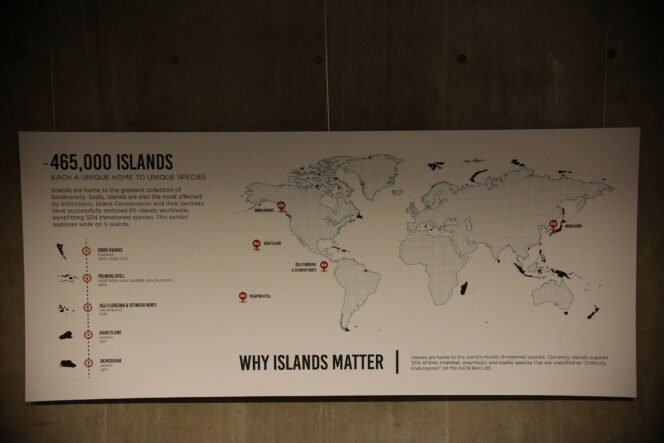
Photo: Christopher Mortenson – Beaty Biodiversity Museum
In addition to the event and the Preventing Extinctions exhibition, the evening is a fabulous opportunity to explore the museum, which houses other exhibitions (Disrupting Wild Echoes by Sarah Ronald until September 25, 2022; Drift by Bettina Harvey, which opens October 20, 2022), an impressive blue whale skeleton in its atrium, as well as over 500 natural history exhibits, including of reptiles, fungi, mammals, and birds. They’re organized into six collections, such as the tetrapods and the marine invertebrates, and then within each collection, they’re organized according to how things are related to one another. “We are looking at the evolutionary relationships globally. It’s drawing out the total interrelatedness of all living things and the diversity of all living things on a species-level,” says Tan.
Tan encourages visitors to Vancouver to come to the museum. “When you visit a place, it’s nice to get to know some of the local ecosystem and the non-human residents—not just the people who live here but the plants and animals who live here. The museum is a great place to get to know our local biodiversity,” Tan says. He says many of the organisms are rare or nocturnal so people will probably not see them as they’re exploring the city.
As well, the fact that the museum is an active site of research on biodiversity makes it unique. It’s not just displaying specimens. “Here, it’s also about what we’re doing about the biodiversity crisis. There are people in the building—and you can run into them on the museum floor—who are working on this problem, and it’s an active research collection,” Tan says. That means researchers are going into the collection and using the specimens to collect data, such as about historical biodiversity levels, changes to them, and what can be done to combat the shifts.
“It’s a cool place to hang out. We’re an underground basement so it’s a nice place to visit when it’s hot and you need somewhere to take the kids,” Tan says. The museum is restarting their Nature Club, which takes place the first Saturday of every month from 10:30am to 1pm. The first one is scheduled for October 1, 2022, and will be on entomology, the study of insects. Kids 5-12 years old, accompanied by an adult, can take part in hands-on activities. Pre-register for each meeting of the Nature Club. Families who live on campus can take part for free. Everyone is welcome.
The museum is open Tuesday to Sunday 10:00am-5:00pm, and is located at 2212 Main Mall on UBC’s main campus.
















